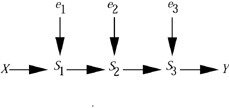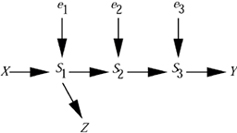Back-door criterion and epidemiology
The definition of the back-door condition (Causality, page 79, Definition 3.3.1) seems to be contrived. The exclusion of descendants of X (Condition (i)) seems to be introduced as an after fact, just because we get into trouble if we dont. Why cant we get it from first principles; first define sufficiency of Z in terms of the goal of removing bias and, then, show that, to achieve this goal, you neither want nor need descendants of X in Z.
The exclusion of descendants from the back-door criterion is not a contrived "fix", but is based indeed on first principles. The principles are as follows: We wish to measure a certain quantity (causal effect) and, instead, we measure a dependency P(y|x) that results from all the paths in the diagram, some are spurious (the back-door paths) and some are genuine (the directed paths). Thus, we need to modify the measured dependency and make it equal to the desired quantity. To do it systematically, we condition on Z while ensuring that:
Principles 1 and 2 are accomplished by blocking all back-door paths and only those paths. Principle 3 requires that we do not condition on certain descendants of X, because such descendants may create new spurious paths between X and Y.
To see why, consider the path




The intermediate variables, S1, S2…, (as well as Y) are affected by noise factor e1, e2,… which are not shown explicitly in the diagram. However, under magnification, the chain unfolds into the graph:
Now imagine that we condition on a descendant Z of S1
Since S1 is a collider, this creates dependency between X and e1 which is equivalent to a back-door path
By principle 3, such spurious paths should not be created.
Note that a descendant Z of X that is not also a descendant of some Si escapes this exclusion; it can safely be conditioned on without introducing bias. (Though it may decrease the efficiency of the associated estimator of the causal effect of X on Y.)
Best wishes,
========Judea Pearl
Comment by judea — March 12, 2007 @ 9:26 pm
There are talks that the Nexus 5 (2015) screen will be 5.2 or 5.7 inches with full HD IPS display. The size will be smaller compared to the Nexus 6, although pixel density is higher, based on the same Android Pit report.
Comment by YSL iPhone 6 + Case — May 28, 2015 @ 12:33 am